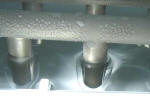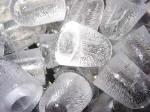
| Home |
| Email John |
| Last update 12/09/2010 |
Product Review: Portable Ice Maker

I decided to give one of these a try so I looked around on the net and found a good price at this site - www.qualitymatters.com. If that link doesn't take you directly to the ice maker, click here. I recommend this site with some hesitation. The price was good and delivery quick but the site lied by promising anonymous ordering without having to set up an account. That is important to me, as I don't like leaving bits of personal financial information drifting around the net. To their credit, they did reply to my email and certify that all identifying info had been deleted from their database. I shouldn't have had to ask.
The package was shipped on a Monday and arrived in a large box on the next Thursday. The actual ice machine box was packaged inside a larger box with foam sheeting in between. Very nice packaging.
Anyway, the specs are roughly thus:
-Produces approx. 12 ice cubes in less than 10 minutes
-3 different cube sizes
-1.2 gallon water reservoir
-Power consumption: 200 W
-Power: 120V / 60Hz
-Rated current: 1.25A
-Refrigerant: R134a / 120g
-Unit dimension (W x D x H): 17" H x 15" W x 17 .125 L"
-Gross weight: 46 lbs
I sat the machine on the counter in my apartment, filled it with a gallon of tap water, connected it through a Kill-A-Watt and turned it on while timing it with a stop-watch.
The Initial power draw was 220 watts, 313 VA for a power factor of 0.69. As the ice began to form on the cold fingers, the power consumption dropped to 153 watts right before the end of the cycle. This is with the condenser fan off. When activated by the controller, the fan adds about 25 watts. The maximum power draw of 265 watts occurs at the very beginning of the defrost cycle when the fan, the compressor and the flipper motor are all running.
With the "size" control set to "medium", the first set of "cubes" started ejecting at 13 minutes, 9 seconds and was complete by 13 minutes, 50 seconds. As the water in the reservoir became chilled, the cycle time shortened to less than 8 minutes.
An ice making cycle starts when an internal pump fills the water tray. Projecting into this tray are 12 "cold fingers", polished tubes that are part of the refrigeration system and get very cold. Ice forms on the fingers in a gradually thickening layer.
After a set time, depending on the "size" setting, the water tray drops down, dumping the remaining water back to the water reservoir. A refrigerant valve opens, admitting hot refrigerant directly from the compressor into the cold fingers. (This is exactly the same process used to defrost a heat pump evaporator in the wintertime when it freezes up.) They practically instantly thaw, allowing the cubes to drop by gravity.
After another set time, the water tray again moves up under the cold fingers. In the process a flipper attached to the tray flips the newly formed cubes into the storage bin. The internal pump fills the water tray and the cycle repeats.
When the ice builds up until it contacts the "full" thermal sensor, the unit is shut down and the "full" LED on the control panel illuminated. As the ice melts, the water returns to the reservoir to be re-used. When the ice melts down or ice is removed for use, the "full" sensor warms up and ice making starts again.
Following are some photos to demonstrate how the maker works
4 out of 5.
Only the sanitation question and the overall size detract from a very nice product.
UPDATE
05/22/06
Click here for an update on this report.

Overall views of the unit


The control panel

Several features are identified in this photo. Note that the drain plug is left hand threaded. The silicone rubber gasket is easily damaged so take care to turn the plug the correct direction.

The ice flipper, the "full" sensor and the water reservoir are visible here. The ice basket sits on the slight ledge so the water level should remain below the ledge to avoid immersing the cubes in water

This photo shows an ice cube forming around a cold finger.

Here several parts of the ice making apparatus are identified. Note the refrigerant tubes on the left and the curved bracket on the right. I had to slightly bend these parts to fully immerse the cold fingers in the water

This shows the beginning of the harvest or dump cycle. The water tray has dropped away, dumping the remaining water back to the sump. The hog gas valve has been opened. Note that the hot gas line on the left has already thawed. In another couple seconds the whole assembly will be warm enough that the cubes fall away by gravity.

Here we see the cubes dropping from the cold fingers. The white flipper attached to the water tray will flip the cubes over the lip and into the storage bin as the water tray returns to position.

Freshly dropped cubes. Or should I call them "thimbles"? :-)

The water tube that fills the ice tray. This tube is supplied from the reservoir by an internal pump. Unfortunately this design causes the water flow to be aerated, resulting in milky cubes. I may look into modifying this to minimize this aeration.

This shows the size difference between a "small" and a "large" cube. Note the difference in length. The small cube was made by the machine as it arrived. For the large cube, I had adjusted the refrigerant line and curved bracket so that the whole finger was immersed in the water.
The "dingleberry" sticking up from the large cube resulted from the finger assembly being too low so that the water contacted the horizontal connecting pipe. I adjusted the assembly slightly upward to get rid of the dingleberry.
While I'm quite satisfied with this machine, I have some concerns about sanitation. Ice melt reenters the water reservoir to be reused in making new cubes. This is fine as long as the lid is kept shut and no one paws the cubes with dirty hands. Unfortunately that cannot be guaranteed, especially when many people are using the machine, such as at a party. Especially if the libations are flowing freely.
Probably the best way to address this problem is to not have the machine accessible to guests and instead empty the basket into an ice bucket.
Even with reasonable precautions against contamination, I would want to sanitize the system every couple of days. The manual doesn't do a very good job of addressing this, vaguely suggesting washing the reservoir with mild soap every so often.
I'm going to sanitize mine following standard restaurant procedures of filling the reservoir with a 100ppm chlorine bleach solution and running a cycle. This will circulate the sanitizing solution throughout the water system. Follow with a clean water flush and drain before filling with water to start ice making again.
I have some thoughts about mounting a small shortwave UV germicidal lamp in the water reservoir to continuously sanitize the water. More on that later.
I tested this unit on a 400 watt inverter and it started and ran just fine. I would expect it to work on a 300-350 watt inverter, though it is getting hard to find one that small these days.
One other thought. I see no reason why a non-corrosive beverage could not be used instead of water to make "beverage cubes". Iced tea, coke, etc. Alcoholic solutions probably wouldn't work well because the water would tend to crystallize out of the solution, leaving the alcohol. I'm going to try some "iced tea cubes" and see how it works.
I have this unit in my apartment and have turned off the ice maker in my
restaurant. I'm a voracious iced tea drinker so this little booger has been
running just about flat out since I got it.
One of my fears has been realized concerning sanitation. The water reservoir
needs to be drained every couple of days if off-taste is to be avoided. The
little drain with its tiny opening makes this a pain so I've started just
flipping the unit upside-down over the bath tub to effect a very rapid drain
:-) I found an ant in the reservoir one time. No, she didn't drink much.
Incidentally, if I didn't mention it before, the drain plug has left-hand
threads. WTF? You're almost guaranteed to strip the soft plastic
trying to unscrew it the "wrong" way so I highly recommend ordering several
spare caps from the vendor.
I use distilled water in the thing because I like the taste,
especially as compared to the hyper-chlorinated city water we have here.
Distilled water is deaerated as a natural byproduct of
distillation. When first put in the machine, the water makes
crystal-clear cubes.
As the machine continues to run, tumbling the water over the tray and back
into the reservoir, the water picks up air and the ice gradually becomes
cloudy. At first, just a few thin air-escape tubules in the clear ice that
gradually builds in quantity. The ice never gets as cloudy as with tap
water, probably because of the lack of chlorine and other dissolved crap.
Before the tubules get too dense the appearance of the ice is quite striking
- a textured sparkling effect.
BTW, I took a stroll through the local Camping World today and noticed that
they have this same machine but with a stainless case for over $300.
Figures.
Executive summary: I still really
like this machine, especially for travel, but I do have to acknowledge that
it requires more maintenance than one would at first think. Regular
sanitation is a must if the cubes are to remain fresh-tasting.

This is a photo of ice made with fresh distilled water. They're orange because I put the first batch in my big orange tea cup before thinking to grab the camera :-)
Notice the total lack of air bubbles and the complete clarity.

A photo of ice made a couple hours later after the water had been tumbled out of the tray and back to the reservoir. The water has absorbed some air which outgases as the ice freezes. It makes these strikingly pretty tubules in the otherwise clear ice.

Ice made after about 24 hours of operation on distilled water. Considerable air has been absorbed and it shows by virtue of the increasing density of tubules. Still strikingly pretty. The ice never gets as cloudy as with tap water, probably because of the lack of minerals and chlorine.